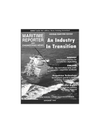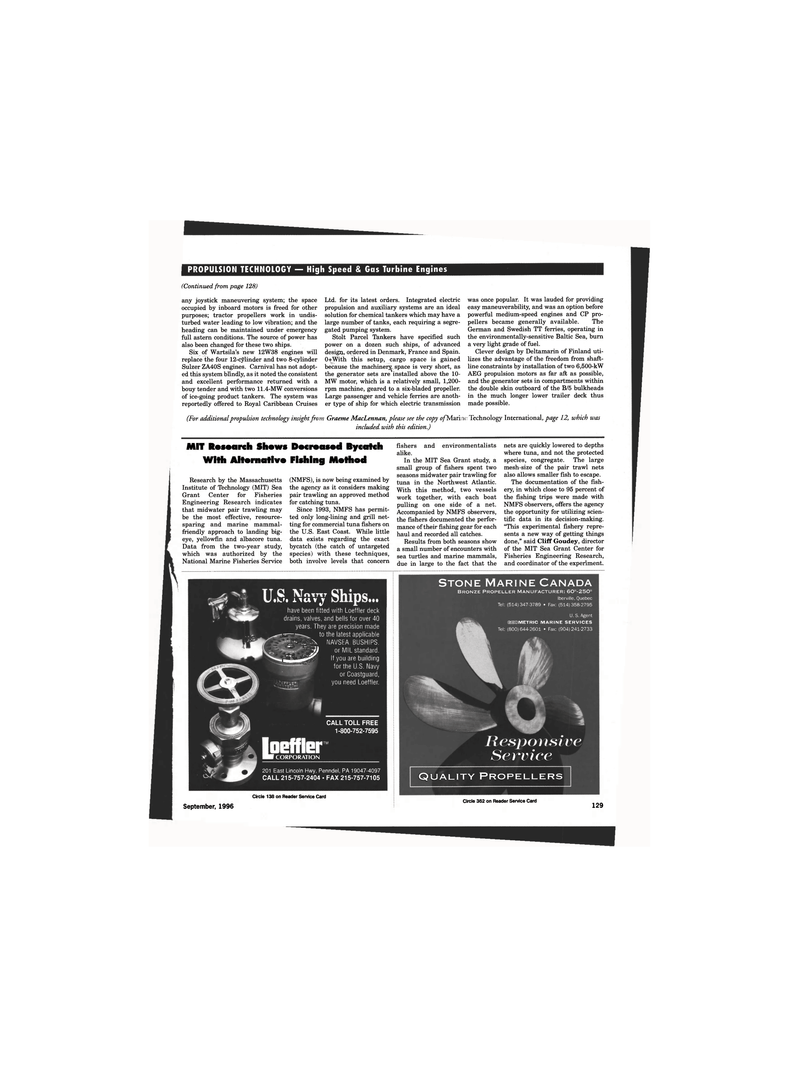
Page 129: of Maritime Reporter Magazine (September 1996)
Read this page in Pdf, Flash or Html5 edition of September 1996 Maritime Reporter Magazine
PROPULSION TECHNOLOGY — High Speed & Gas Turbine Engines (Continued from page 128) any joystick maneuvering system; the space occupied by inboard motors is freed for other purposes; tractor propellers work in undis- turbed water leading to low vibration; and the heading can be maintained under emergency full astern conditions. The source of power has also been changed for these two ships.
Six of Wartsila's new 12W38 engines will replace the four 12-cylinder and two 8-cylinder
Sulzer ZA40S engines. Carnival has not adopt- ed this system blindly, as it noted the consistent and excellent performance returned with a bouy tender and with two 11.4-MW conversions of ice-going product tankers. The system was reportedly offered to Royal Caribbean Cruises (For additional propulsion technology insight fro
Ltd. for its latest orders. Integrated electric propulsion and auxiliary systems are an ideal solution for chemical tankers which may have a large number of tanks, each requiring a segre- gated pumping system.
Stolt Parcel Tankers have specified such power on a dozen such ships, of advanced design, ordered in Denmark, France and Spain.
O+With this setup, cargo space is gained because the machinery space is very short, as the generator sets are installed above the 10-
MW motor, which is a relatively small, 1,200- rpm machine, geared to a six-bladed propeller.
Large passenger and vehicle ferries are anoth- er type of ship for which electric transmission
Graeme MacLennan, please see the copy o/"Mari: included with this edition.) was once popular. It was lauded for providing easy maneuverability, and was an option before powerful medium-speed engines and CP pro- pellers became generally available. The
German and Swedish TT ferries, operating in the environmentally-sensitive Baltic Sea, burn a very light grade of fuel.
Clever design by Deltamarin of Finland uti- lizes the advantage of the freedom from shaft- line constraints by installation of two 6,500-kW
AEG propulsion motors as far aft as possible, and the generator sets in compartments within the double skin outboard of the B/5 bulkheads in the much longer lower trailer deck thus made possible. : Technology International, page 12, which was
MIT Research Shews Decreased Bycatch
With Alternative Fishing Method
Research by the Massachusetts
Institute of Technology (MIT) Sea
Grant Center for Fisheries
Engineering Research indicates that midwater pair trawling may be the most effective, resource- sparing and marine mammal- friendly approach to landing big- eye, yellowfin and albacore tuna.
Data from the two-year study, which was authorized by the
National Marine Fisheries Service (NMFS), is now being examined by the agency as it considers making pair trawling an approved method for catching tuna.
Since 1993, NMFS has permit- ted only long-lining and grill net- ting for commercial tuna fishers on the U.S. East Coast. While little data exists regarding the exact bycatch (the catch of untargeted species) with these techniques, both involve levels that concern fishers and environmentalists alike.
In the MIT Sea Grant study, a small group of fishers spent two seasons midwater pair trawling for tuna in the Northwest Atlantic.
With this method, two vessels work together, with each boat pulling on one side of a net.
Accompanied by NMFS observers, the fishers documented the perfor- mance of their fishing gear for each haul and recorded all catches.
Results from both seasons show a small number of encounters with sea turtles and marine mammals, due in large to the fact that the nets are quickly lowered to depths where tuna, and not the protected species, congregate. The large mesh-size of the pair trawl nets also allows smaller fish to escape.
The documentation of the fish- ery, in which close to 95 percent of the fishing trips were made with
NMFS observers, offers the agency the opportunity for utilizing scien- tific data in its decision-making. "This experimental fishery repre- sents a new way of getting things done," said Cliff Goudey, director of the MIT Sea Grant Center for
Fisheries Engineering Research, and coordinator of the experiment. r« iittvj have been fitted with Loeffler deck drains, valves, and bells for over 40 years. They are precision made r—to the latest applicable „ \ NAVSEA. BUSHIPS. " or MIL standard. m^mff^1^ If you are building for the U.S. Navy or Coastguard, you need Loeffler.
CALL TOLL FREE 1-800-752-7595
CORPORATION 201 East Lincoln Hwy, Penndel, PA 19047-4097
CALL 215-757-2404 • FAX 215-757-7105
STONE MARINE CANADA
BRONZE PROPELLER MANUFACTURER: 60"-250"
Iberville, Quebec
Tel: (514)347-3789 • Fax: (514)358-2795
Circle 138 on Reader Service Card
September, 1996
Circle 362 on Reader Service Card 129
U. S. Agent ®H®METRIC MARINE SERVICES
Tel: (800)644-2601 • Fax: (904)241-2733
Service
QUALITY PROPELLERS

 128
128

 130
130
